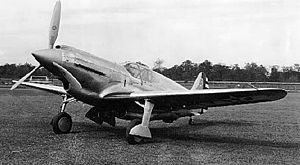avia.wikisort.org - Aeroplane
The Curtiss XP-46 was a 1940s American prototype fighter aircraft. It was a development of the Curtiss-Wright Corporation in an effort to introduce the best features found in European fighter aircraft in 1939 into a fighter aircraft which could succeed the Curtiss P-40, then in production.
Design and development
A United States Army Air Corps (USAAC) specification based upon a Curtiss proposal was the basis for an order placed in September 1939 for the XP-46. The requirements called for a single-engine, low-wing aircraft, slightly smaller than the P-40, and with a wide-track, inward-retracting landing gear. The selected powerplant was a 1,150 hp (858 kW) Allison V-1710-39 V-12 engine. The planned armament included two .50 in (12.7 mm) synchronized machine guns in the forward fuselage and provisions for eight .30 in (7.62 mm) wing-mounted guns. The USAAC later added requirements for self-sealing fuel tanks and 65 lb (29 kg) of armor, the weights of which were to adversely affect performance.
Testing
In 1940 the British Purchasing Commission placed an order for the P-46 as a replacement for the P-40,[1] the name 'Kittyhawk' being allocated by the Air Ministry in anticipation of receiving the aircraft.[2]
However, the USAAC asked Curtiss in July 1940 – while the XP-46 prototypes were under construction – to prioritize an upgraded P-40, featuring the engine intended for the XP-46. This would also avoid disruptions to the production line caused by any switch to a new airframe. The British order for the P-46 was later cancelled,[1] and the 'Kittyhawk' name subsequently applied to the upgraded P-40.
Two prototypes, designated XP-46A, were nevertheless delivered to the USAAC; the first flight occurred on 15 February 1941. The type's performance during trials was found to be inferior to the then-contemporary P-40D. As the P-46 offered no significant improvement on the P-40, the program was cancelled.[3]
A myth claims that work on the XP-46 was the basis of the North American NA-73X – the prototype P-51 Mustang. While North American Aviation (NAA) purchased technical aerodynamic data on the P-40 and XP-46 from Curtiss for $56,000, and there are certain design similarities in the radiator/oil-cooler configuration of the two types, North American had already made significant progress on its design.[4][5]
Specifications (Curtiss XP-46A)

Data from Curtiss Aircraft 1907–1947[6]
General characteristics
- Crew: 1
- Length: 30 ft 2 in (9.19 m)
- Wingspan: 34 ft 3.75 in (10.4585 m)
- Height: 10 ft 1 in (3.07 m)
- Wing area: 208 sq ft (19.3 m2)
- Airfoil: root: NACA 23016.5; tip: NACA 23009[7]
- Empty weight: 5,625 lb (2,551 kg)
- Gross weight: 7,665 lb (3,477 kg)
- Powerplant: 1 × Allison V-1710-39 V-12 liquid-cooled piston engine, 1,150 hp (860 kW)
- Propellers: 3-bladed constant-speed propeller
Performance
- Maximum speed: 355 mph (571 km/h, 308 kn) at 12,200 ft (3,700 m)
- Range: 325 mi (523 km, 282 nmi)
- Time to altitude: 12,300 ft (3,700 m) in 5 minutes
Armament
- Guns:
- 2 × 0.50 in (13 mm) synchronized machine guns in the forward fuselage
- Provision for 8 × 0.30 in (7.6 mm) wing-mounted guns
See also
- Curtiss P-40
- Curtiss XP-42 - an earlier design also intended to replace the P-40, but not put into production
- North American P-51 Mustang
- Curtiss XP-53/YP-60 – a series of designs developed from the XP-46
References
Notes
- Engel, Leonard. "Half of Everything: An American's Survey of Orders Placed in the United States." Flight, 5 December 1940, p. 472.
- "Archived copy". Archived from the original on 2016-08-04. Retrieved 2016-06-03.
{{cite web}}: CS1 maint: archived copy as title (link) - Berliner 2011, p. 18.
- Baugher, Joe. "North American NA-73." USAAC/USAAF/USAF Fighter and Pursuit Aircraft: North American P-51 Mustang, 29 August 1999. Retrieved: 10 August 2010.
- Note: The British Air Ministry insisted NAA purchase the Curtiss data as in 1940 the former company had no experience of high speed flight, its previous fastest design being the Harvard trainer. The data was insisted upon so that NAA had aerodynamic data at high subsonic Mach numbers of an existing high speed fighter as guidance during the design of the NA-73.[citation needed]
- Bowers, Peter M. (1979). Curtiss aircraft, 1907-1947. London: Putnam. pp. 435–436. ISBN 0370100298.
- Lednicer, David. "The Incomplete Guide to Airfoil Usage". m-selig.ae.illinois.edu. Retrieved 16 April 2019.
Bibliography
- Berliner, Don. Surviving Fighter Aircraft of World War Two: Fighters. London: Pen & Sword Aviation, 2011. ISBN 978-1-8488-4265-6.
- Bowers, Peter M. Curtiss Aircraft, 1907-1947. London: Putnam & Company Ltd., 1979. ISBN 0-370-10029-8.
- Green, William. War Planes of the Second World War, Volume Four: Fighters. London: MacDonald & Co. (Publishers) Ltd., 1961 (Sixth impression 1969). ISBN 0-356-01448-7.
- Green, William and Gordon Swanborough. WW2 Aircraft Fact Files: US Army Air Force Fighters, Part 1. London: Macdonald and Jane's Publishers Ltd., 1977. ISBN 0-356-08218-0.
External links
На других языках
- [en] Curtiss XP-46
[fr] Curtiss XP-46
Le Curtiss XP-46 était un prototype de chasseur américain des années 1940. Il était issu d'un développement entrepris en 1939 par la Curtiss-Wright Corporationn visant à incorporer les meilleures caractéristiques trouvées sur les chasseurs européens à un chasseur qui pourrait assurer la succession du P-40 Warhawk, alors en cours de production.[it] Curtiss XP-46
Il Curtiss XP-46 fu un aereo da caccia monoposto, monomotore e monoplano ad ala bassa sviluppato dall'azienda aeronautica statunitense Curtiss-Wright Corporation tra i tardi anni trenta e i primi anni quaranta e rimasto allo stadio di prototipo.Другой контент может иметь иную лицензию. Перед использованием материалов сайта WikiSort.org внимательно изучите правила лицензирования конкретных элементов наполнения сайта.
WikiSort.org - проект по пересортировке и дополнению контента Википедии
